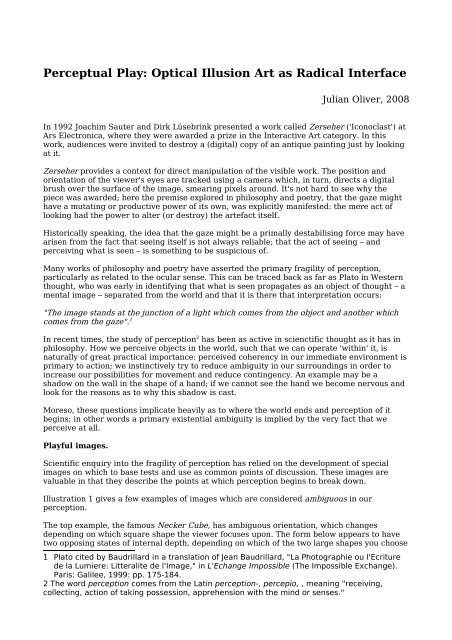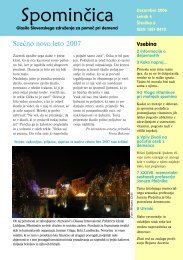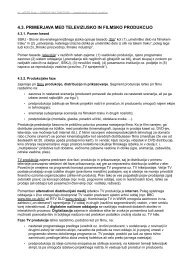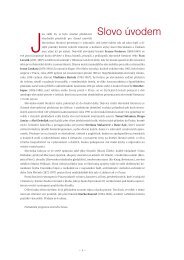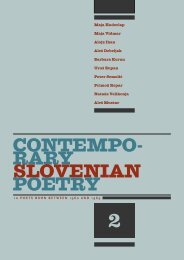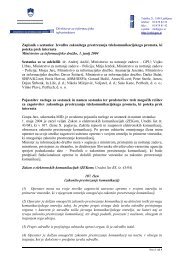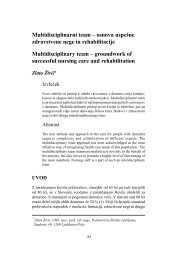Perceptual Play: Optical Illusion Art as Radical Interface - Julian Oliver
Perceptual Play: Optical Illusion Art as Radical Interface - Julian Oliver
Perceptual Play: Optical Illusion Art as Radical Interface - Julian Oliver
Create successful ePaper yourself
Turn your PDF publications into a flip-book with our unique Google optimized e-Paper software.
<strong>Perceptual</strong> <strong>Play</strong>: <strong>Optical</strong> <strong>Illusion</strong> <strong>Art</strong> <strong>as</strong> <strong>Radical</strong> <strong>Interface</strong><br />
<strong>Julian</strong> <strong>Oliver</strong>, 2008<br />
In 1992 Joachim Sauter and Dirk Lüsebrink presented a work called Zerseher ('Iconocl<strong>as</strong>t') at<br />
Ars Electronica, where they were awarded a prize in the Interactive <strong>Art</strong> category. In this<br />
work, audiences were invited to destroy a (digital) copy of an antique painting just by looking<br />
at it.<br />
Zerseher provides a context for direct manipulation of the visible work. The position and<br />
orientation of the viewer's eyes are tracked using a camera which, in turn, directs a digital<br />
brush over the surface of the image, smearing pixels around. It's not hard to see why the<br />
piece w<strong>as</strong> awarded; here the premise explored in philosophy and poetry, that the gaze might<br />
have a mutating or productive power of its own, w<strong>as</strong> explicitly manifested: the mere act of<br />
looking had the power to alter (or destroy) the artefact itself.<br />
Historically speaking, the idea that the gaze might be a primally destabilising force may have<br />
arisen from the fact that seeing itself is not always reliable; that the act of seeing – and<br />
perceiving what is seen – is something to be suspicious of.<br />
Many works of philosophy and poetry have <strong>as</strong>serted the primary fragility of perception,<br />
particularly <strong>as</strong> related to the ocular sense. This can be traced back <strong>as</strong> far <strong>as</strong> Plato in Western<br />
thought, who w<strong>as</strong> early in identifying that what is seen propagates <strong>as</strong> an object of thought – a<br />
mental image – separated from the world and that it is there that interpretation occurs:<br />
"The image stands at the junction of a light which comes from the object and another which<br />
comes from the gaze". 1<br />
In recent times, the study of perception 2 h<strong>as</strong> been <strong>as</strong> active in scienctific thought <strong>as</strong> it h<strong>as</strong> in<br />
philosophy. How we perceive objects in the world, such that we can operate 'within' it, is<br />
naturally of great practical importance: perceived coherency in our immediate environment is<br />
primary to action; we instinctively try to reduce ambiguity in our surroundings in order to<br />
incre<strong>as</strong>e our possibilities for movement and reduce contingency. An example may be a<br />
shadow on the wall in the shape of a hand; if we cannot see the hand we become nervous and<br />
look for the re<strong>as</strong>ons <strong>as</strong> to why this shadow is c<strong>as</strong>t.<br />
Moreso, these questions implicate heavily <strong>as</strong> to where the world ends and perception of it<br />
begins; in other words a primary existential ambiguity is implied by the very fact that we<br />
perceive at all.<br />
<strong>Play</strong>ful images.<br />
Scientific enquiry into the fragility of perception h<strong>as</strong> relied on the development of special<br />
images on which to b<strong>as</strong>e tests and use <strong>as</strong> common points of discussion. These images are<br />
valuable in that they describe the points at which perception begins to break down.<br />
Illustration 1 gives a few examples of images which are considered ambiguous in our<br />
perception.<br />
The top example, the famous Necker Cube, h<strong>as</strong> ambiguous orientation, which changes<br />
depending on which square shape the viewer focuses upon. The form below appears to have<br />
two opposing states of internal depth, depending on which of the two large shapes you choose<br />
1 Plato cited by Baudrillard in a translation of Jean Baudrillard, "La Photographie ou l'Ecriture<br />
de la Lumiere: Litteralite de l'Image," in L'Echange Impossible (The Impossible Exchange).<br />
Paris: Galilee, 1999: pp. 175-184.<br />
2 The word perception comes from the Latin perception-, percepio, , meaning "receiving,<br />
collecting, action of taking possession, apprehension with the mind or senses."
Illustration 1: A series of 'difficult' or<br />
ambiguous images.<br />
to look at. The third form h<strong>as</strong> arrows of either black or<br />
white. Such ambiguity is sometimes referred to <strong>as</strong> bistable<br />
or multistable perception and w<strong>as</strong> widely used by Dutch<br />
artist M.C Escher in the creation of his works. Escher w<strong>as</strong><br />
very inspired by the work of mathematician and physicist<br />
Roger Penrose and directly appropriated some of his<br />
multistable or impossible images. The most apparent<br />
example of this are the famous Penrose Stairs, which appear<br />
to go both up and down when 'traversed' with the eyes<br />
(Illustration 2).<br />
Op <strong>Art</strong><br />
simultaneously play with this relation.<br />
Ambiguity and impossibility<br />
in visual perception have<br />
been widely exploited by<br />
artists over the centuries,<br />
resulting in a rich body of<br />
work whose common thread<br />
is to provide a context to<br />
play with perception itself.<br />
Illustration 2: Penrose Stairs<br />
These objects of art are<br />
strange in that they draw attention to the relationship<br />
between seeing and sense-making, while allowing us to<br />
In these works, the artwork itself is a support designed to trigger a kind of interaction not<br />
normally considered within the realm of Interactive <strong>Art</strong>, which prioritises physical input<br />
and/or direct manipulation of the work being engaged.<br />
Instead, such <strong>Optical</strong> <strong>Illusion</strong> <strong>Art</strong> (or Op <strong>Art</strong> <strong>as</strong> it w<strong>as</strong> coined in a 1964 Time Magazine)<br />
provides for interaction by opening a critical space between seeing and perceiving, in an<br />
effort to encourage exploration of the mechanisms at work.<br />
Op <strong>Art</strong> is a form of pure abstraction. The characteristics and formal qualities of this work are<br />
purposefully designed to produce perceptual abberations, illusions, and visual conundrums<br />
rather than serve <strong>as</strong> strictly aesthetic, narrative or representative supports. By being difficult<br />
to perceive it can be argued that much of these works are never 'seen' in their entirety: they<br />
oscillate in and out of multiple orientations, movements and states just by looking at them.<br />
The French-Hungarian Victor V<strong>as</strong>arely is<br />
considered the primary pioneer of this line<br />
or work, with Bridget Riley soon to follow<br />
<strong>as</strong> a prolific and significant contributor to<br />
the field. Illustration 3 shows V<strong>as</strong>arely's<br />
AXO.<br />
At first glance AXO is clearly reminiscent of<br />
the Necker Cube above, driving us to<br />
attempt to satisfy the cognitive need to<br />
reduce ambiguity and build a coherent<br />
visual model of what is seen.<br />
Operating in the work are several factors<br />
that cause this instability:<br />
Illustration 3: V<strong>as</strong>arely's AXO (1977). Note visual<br />
device similar to Necker Cube at work<br />
Initially it appears <strong>as</strong> an orthographic<br />
projection of either 2 or 3 cubiod forms.<br />
Each 'plane' of these forms are tesselated<br />
in one of 3 combinations of colour pairs,<br />
giving the appearance of lit surfaces.
Due to the perception that light is at work on these regions, we make <strong>as</strong>sumptions of both<br />
form and orientation, looking for a coherent geometric situation that can accommodate all<br />
cubes at once. Our eyes move around the surface of the 2D pattern over and over pushing and<br />
popping orientations in an attempt to find a situation of geometric coherence. Regardless, our<br />
attempts to stabilise AXO <strong>as</strong> a whole image are thwarted indefinitely.<br />
Strangely enough, the most difficult and revealing challenge this work presents us is simply to<br />
view it <strong>as</strong> it is: a flat plane of squares and diamonds of varying colour. Perhaps only then we<br />
can claim to have perceived the work <strong>as</strong> an entirety.<br />
AXO somehow manages to simultaneously express many geometric states of the same<br />
object(s), something Husserl refers to <strong>as</strong> an object “variously presented”, offering itself <strong>as</strong> a<br />
counter-intuitive single-presentation of objects seen simultaneously in several different ways.<br />
[...] in which such series of perceptions with their changing sensuous images take their<br />
courses, intuitive consciousness not of a changing multiplicity but rather of one and the same<br />
object that is variously presented.<br />
Rather than exploring geometric impossibility, British artist Bridget Riley exploits aberrations<br />
in the way we perceive certain patterns to produce sensations of falling and movement.<br />
Riley's work is less interested in ambiguous and impossible images than those which I will call<br />
“motion-unstable” images. Much of her work h<strong>as</strong> sought to design and trial conditions (or<br />
rules) where coherent perception breaks down and work which is known to be static in nature<br />
appears to move and slide around.<br />
One particular work of Riley's exemplifies this<br />
in detail: Movement In Squares, seen in<br />
Illustration 4, begins with squares at the<br />
periphery of the painting and gradually scales<br />
them laterally until they are very thin at the<br />
center. This not only produces the idea that<br />
composition is comprised of two curved 'sheets'<br />
but when studied for some seconds, they<br />
appear to be somehow rolling toward this<br />
vertical center. This movement is due to a<br />
human tendency to perceive lateral gradations<br />
<strong>as</strong> implicative of movement 3 .<br />
Illustration 4: Bridget Riley's Movement in Squares,<br />
1961<br />
even movement.<br />
In effect Riley h<strong>as</strong> created a 3 dimensional<br />
interactive work from purely static 2<br />
dimensional components by exploiting an<br />
innate human tendency to follow pattern, to<br />
read it <strong>as</strong> something descriptive of form and<br />
Here Riley h<strong>as</strong> formalised a rule, a condition for playing with perception, which acts <strong>as</strong> the<br />
b<strong>as</strong>is of a revealing game.<br />
All Op <strong>Art</strong> positions perception <strong>as</strong> prone to error, interrogates its reliability and situates<br />
perception itself <strong>as</strong> the primary exhibition context. It challenges seeing <strong>as</strong> an immaculate<br />
carrier in the reliable transmission of information and provides a formal toolkit for playing<br />
with it.<br />
Perspectival Anamorphosis and Trompe-l'Oeil<br />
Experimenting with the creation of imagery that played with perception w<strong>as</strong> prevalent several<br />
hundred years before the popular term Op <strong>Art</strong> appeared.<br />
3 This effect is probably due to the phenomenon of lateral inhibition in the perception of<br />
gradients in mammals. See Roy Lachman, Janet Lachman, Earl C. Butterfield, Cognitive<br />
Psychology and Information Processing, 1979. Also see phenomenon of Mach Bands.
Perhaps the earliest occurences were found in Judeo Christian cathedrals, where the desire to<br />
depict depth in mythological scenes on flat or near-flat surfaces led to the development of<br />
illusions that appear to defy their architectural context. Similar techniques were used to<br />
'extend' the architecture itself such that the cathedral or church appeared to have greater<br />
dimension than it actually had. This illusion of upward depth became popular and w<strong>as</strong> given<br />
the Italian name Sotto in Su, or “from below, upward”.<br />
Illustration 5 shows this at work: the large dome apparent is painted on a barely curved<br />
surface.<br />
Illustration 5: Trompe L'Oeil on the Jesuit Church, Vienna, by<br />
Andrea Pozzo. Large dome visible is a work of perspectival<br />
illusion.<br />
Illustration 6 is an example.<br />
These works deploy an advanced<br />
geometric distortion – or 'projection' - such<br />
that when the work is seen from the correct<br />
position it operates on the visual senses <strong>as</strong><br />
intended, perceived <strong>as</strong> depth where it<br />
doesn't otherwise exist.<br />
In this configuration, position is primary in<br />
the interaction. The body becomes a cursor<br />
of sorts that allows for the viewer to drive<br />
in and out of the illusion. This kind of<br />
optical illusion is actively participatory and<br />
is an early example of a work designed to<br />
manifest in direct response to userinput,<br />
played into existence through the<br />
body.<br />
Like a great many contemporary<br />
interactive artworks, this participatory<br />
action incorporates the body in the<br />
perception of the work.<br />
Using projectors and other techniques <strong>as</strong> a<br />
kind of 'stencilling' tool, large outdoor<br />
geometric abstractions have been created<br />
that are also activated in a similar way.<br />
These works fall under the name Perspectival Anamorphosis and generally serve no other aim<br />
than to explore the raw mechanics of creating impressive illusions using minimal geometric<br />
description.<br />
Here we have a curious difference between Trompe-l'Oeil and Perspectival Anamorphosis: the<br />
support, a scene of great corporeal depth, is rendered flat by the illusion such that the world -<br />
for a moment - becomes an image or screen.<br />
Moreso, it only becomes an image because of the drive to produce coherency from apparent<br />
visual stimuli: we are satisfied when the seemingly disparate fragments align, completing an<br />
image and allowing for the production of sense.
Considering this <strong>as</strong> a work of art<br />
becomes difficult when we look<br />
for an artefact, or even a<br />
delimited region to which we<br />
direct our enquiry. The work<br />
operates at the intersection of a<br />
sensory input, the perceptive<br />
faculties, a great variety of<br />
objects, their surfaces and a<br />
privileged point in space.<br />
Illustration 6: Large outdoor work of Perspectival Anamorphosis. Felice<br />
Varini, St Etienne, 2005.<br />
rather than raw semiotic interpretation.<br />
Both Trompe-l'Oeil and<br />
Perspectival Anamorphosis can<br />
be understood <strong>as</strong> a kind of<br />
sensory projection, bound<br />
between the world and the sensemaking<br />
apparatus. It provides a<br />
context for playing in the space<br />
between sense and sensed,<br />
These works are not so much comprised of things or signs <strong>as</strong> 'events of sense', described by<br />
complex relations between the body, what is seen and how it is seen.<br />
In these works belief, <strong>as</strong> a transport for investment, is<br />
primary in the success of the work; it collaborates<br />
with the cognitive desire to seek coherency in the<br />
formation of single, logical, perceptual propositions<br />
and it's here that the work lives and is interacted<br />
upon. We know the image of concentric circles<br />
doesn't exist in the world but against doubt it shouts<br />
out its form in the mind.<br />
It is upon this image that the audience interacts,<br />
moving toward belief or away from it by changing<br />
bodily position in pursuit of the possibility, a very<br />
lively example of interaction in what is (formally<br />
speaking) a static artwork.<br />
The artists are exploiting 'flaws' and special<br />
conditions in seeing, such that a known-untruth can<br />
rise – even if just for a moment – into belief. The<br />
resulting works can therefore be understood <strong>as</strong><br />
formal experiments in producing the conditions for an<br />
augmentation of reality – a game of make believe.<br />
This work proposes a radical kind of interaction<br />
design precisely because it shifts the object of interaction from the corporeal into the<br />
perceptual: beyond augmentation of the environment it is an augmentation of perception<br />
itself, replaying belief against known doubt with the agent <strong>as</strong> both lens (eyes) and steering<br />
controller (body movement).
Illustration 7: Another perspective defying work by Varini<br />
Illustration 8: Same hall seen from different angle and<br />
position<br />
Consider a screen-b<strong>as</strong>ed interactive artwork - an artistic 3D game for example - and any<br />
supposed gulf between Interactive <strong>Art</strong> and this work is quickly challenged.<br />
A 3D game uses a 3D graphics engine to produce the illusion of three dimensional space<br />
through the shading and skewing of triangles, all of which are drawn flat within a 2D 'surface'<br />
of pixels. There is no depth in a 3D game, merely the projection of it using a software camera<br />
whose view matrix transforms polygons – <strong>as</strong> atoms of representative space - in such a way <strong>as</strong><br />
to give the impression of perspective. Illustration 9 describes this using a cube form <strong>as</strong> an<br />
example.<br />
The player uses his or her arms and<br />
fingers to shift the point of view in<br />
response to what is seen on the<br />
screen of a 3D game. The screen, <strong>as</strong><br />
the final 2D surface upon which all<br />
the triangles are drawn, is<br />
comparable to the flat mental image<br />
perceived in Perspectival<br />
Anamorphosis.<br />
<strong>Play</strong>ing with Instability<br />
Illustration 9: Polygons appear 3 dimensional but are actually<br />
drawn flat on the view plane<br />
Reading the ambgiuous images of<br />
V<strong>as</strong>arely or the motion-unstable work<br />
of Riley <strong>as</strong> interactive art is not <strong>as</strong><br />
conveniently e<strong>as</strong>y <strong>as</strong> with the above<br />
perspectival works. Nonetheless to<br />
do so only requires deeper<br />
interrogation of what constitutes<br />
interfacing in the context of<br />
perception.
Ambiguous Op <strong>Art</strong> like that of AXO can be considered to contain several stable mental images<br />
whose axiomatic and opposing spatial properties undermine attempts at building a coherent<br />
scene in the mind. Each of these images – for instance the cubic forms in various orientations<br />
– are completed <strong>as</strong> rational perceptual objects in the mind through which we cycle <strong>as</strong><br />
dominant logical propositions that might help us reach coherency.<br />
Each of these stable sub-images can be considered interactive regions within the work.<br />
The game – if one could call it that - is<br />
built around futile attempts to reach<br />
coherence. Through this work, the<br />
viewer plays with multiple stable<br />
images by moving the eyes and<br />
making believe in an attempt to reach<br />
this goal, a goal already abstractly<br />
prescribed by a primary and urgent<br />
drive in the perceptual faculties<br />
themselves.<br />
Like Zerseher, the position of the<br />
eyes directly transforms what is<br />
perceived but without manipulating<br />
the surface of the painting.<br />
Moreso, the work (the interface) of<br />
AXO operates <strong>as</strong> a kind of illogical<br />
machine comprised of several<br />
dissonant propositions, or 'actors', in<br />
the mind. Illustration 10 shows the<br />
four primary stable but opposing<br />
images in AXO.<br />
Illustration 10: The four stable images perceptible in AXO<br />
AXO is in essence a puzzle. Riley's<br />
work however catches us off guard entirely and plays with us; suspended between the<br />
impossibility of what we know to be a static image and a wriggling form produced by a<br />
perceptual aberration.<br />
With much of Riley's work there is nothing more to do than play live with these retinal and<br />
cognitive 'abberations', performing experiments with the phenomenon.<br />
She says of her work:<br />
"In my earlier paintings, I wanted the space between the picture plane and the spectator to<br />
be active. It w<strong>as</strong> in that space, paradoxically, the painting 'took place [...]'"<br />
Conclusion:<br />
<strong>Perceptual</strong> <strong>Play</strong> of the kind seen in <strong>Optical</strong> <strong>Illusion</strong> <strong>Art</strong> may expand the scope of what is<br />
considered Interactive <strong>Art</strong> by configuring perceptual disparities, aberrations and illusions <strong>as</strong><br />
playable interactive components which are engaged using body-location and/or eye-movement<br />
<strong>as</strong> interactors.<br />
While it is convenient to view these works <strong>as</strong> singular painted artefacts – and using traditional<br />
methods of production – they were implemented with the strategic aim of interaction and play<br />
in mind <strong>as</strong> a kind of programmed and formal perceptual intervention. In doing this, they<br />
situate perceptual subjectivity <strong>as</strong> a site for immediate, playful experimentation and outside of<br />
an obligation to semantic interpretation or traditional - primarily material - interaction-design<br />
modes.<br />
While it is certainly difficult to imagine programming or designing for this space with<br />
meaningful interaction in mind, work of this kind represents a valid and undoubtedly<br />
interactive design paradigm in the exploration of perceptual models and tendencies.
Bibliography:<br />
Roy Lachman, Janet Lachman, Earl C. Butterfield, Cognitive Psychology and Information<br />
Processing, 1979.<br />
Michael Morgan, The Space Between Our Ears, Weidenfeld and Nicolson 2003.<br />
OpenGL Architecture Review Board, OpenGL Reference Manual, Addison Wesley<br />
Publishing Company 1994.<br />
Gilles Deleuze, The Logic of Sense, Continuum, 2004<br />
Edmund Husserl, Cartesian Meditations, 1931 (See English version at Archive.org)<br />
Illustrations:<br />
Images 1, 2, 4 and 5 sourced from WikiMedia Commons.<br />
Images 9 and 10 produced by <strong>Julian</strong> <strong>Oliver</strong><br />
Remaining images fall under the copyright of their respective authors.<br />
Copyright (c) 2008 by <strong>Julian</strong> <strong>Oliver</strong>. This material may be distributed only subject to the terms and conditions<br />
set forth in the Creative Commons Attribution 2.0 License. It can be found at this address:<br />
http://creativecommons.org/licenses/by/2.0/legalcode


